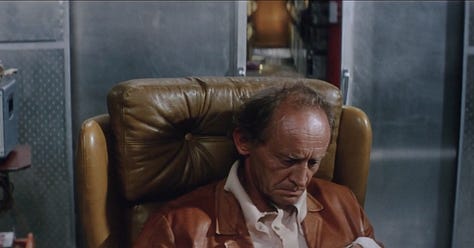Going in Circles: SOLARIS
This scene from Solaris (1979) is hypnotic, disorienting, and effective.
While a single shot moving in (mostly one-directional) circles has its own purposes, the ‘punch line’ transition is all the more effective because the two-minute-plus oner has lulled us into its rhythm.
We’re talking flow and vibes, practical tricks to pulling off a two-handed oner, and that punch line!
Going in Circles
Circles can be dizzying and disorienting, but also hypnotic and soothing. In this scene, they’re a bit of both!
Kris Kelvin (Donatas Banionis, black jacket) has recently arrived on the space station to find his colleague died of violent erratic causes. Dr Snaut (Jüri Järvet, brown jacket) is trying to sooth — and perhaps control — Kelvin.
The camera constantly moving holds our attention even between breaks in conversation, while going in constant sweeping arcs and circles also gives us feelings similar to Kelvin: confused and unstable but unable to ‘snap out of’ the inexorable continuation of movements and speaking or events to get his mind wrapped around what’s happening let alone do anything about it.
Kind of like the run-on sentence immediately above, a continually drifting camera movement doesn’t give our brains the same kind of pauses as a shot-reverse-shot edit or a full stop. does.
Practicalities
When a camera moves around one open space as characters leave frame on one side and enter another, you’ve got to get creative when actors are off-screen!
This type of blocking occurs a few times, we’ve picked one sample and then diagrammed the movements below.
sound
First things first, you may notice the dialogue is not quite in-sync with the mouths. In an unusual process, both of these actors (and only these two) are dubbed by two other actors all through the film! But even if they weren’t already dubbed, because of the filming method here, they would have re-recorded all their lines for this scene in post.
Tarkovsky wanted the eerie silence of space, which some Solaris scenes could have enabled — eg. shooting in a controlled environment or sound stage where the camera wasn’t moving — but not this one!
Between huge camera equipment moving, the crew operating gear and wrangling cables (and possibly set elements and props) on the fly, actors running around (while wearing noisy leather!), the director or AD verbally cueing actors when to turn or deliver a line, etc., the noise would have been anything but vacuum-of-space-y.
vision
Once Dr Snaut motivates the camera away from Kelvin, Banionis would have to run around the camera and get into place to calmly, coolly wait for the camera to drift over. The cans of food give a good ‘excuse’ for the camera to linger, buying Banionis a few extra seconds.
Like so:
Once Snaut is off-camera (0:20), he’s settling back in his chair, waiting to perform his Bond-villain-esque spin which motivates the cut out of the scene.
Punch Line
The next scene begins with a door moving L-R (2:20 in the full video up top), which roughly continues the motion of the chair as it was spinning L-R or clockwise . . . but that’s almost the only thing which is continuous instead of jarring.
First, even though the L-R motion continues ‘across’ the two shots, the camera has been taking us R-L for most of the oner, so this movement is opposite to the prior two minutes.
It also goes from organic (Snaut and his leather chair) to inorganic, muted yellows and dull metal to stark red brighter blue-white, softer contours to hard-edged squares, all before the door’s quick jarring movement and swift light change happen!
The three frames below all occur within three seconds; this jarring transition is in sharp contrast to the flowing oner which ran without hard cuts or rapid light changes.



The effect of the short sharp cut and jerky movement and light switch is enunciated even more because our brain has to rapidly switch gears.
Tarkovsky intends to and succeeds in throwing us off-kilter.
Takeaways
Film gives us a million different ways to reach a desired feeling.
If you want to keep your audience off-balance, you could literally tilt your camera, frenetically edit a scene, use harsh lighting, etc. . . . but you could also use smooth movement, unexpected blocking, and sudden juxtaposition.



